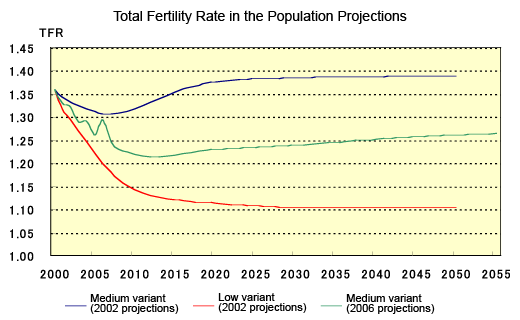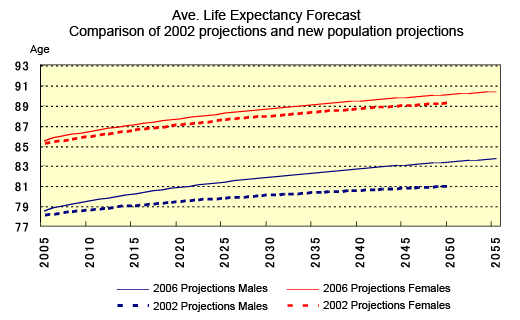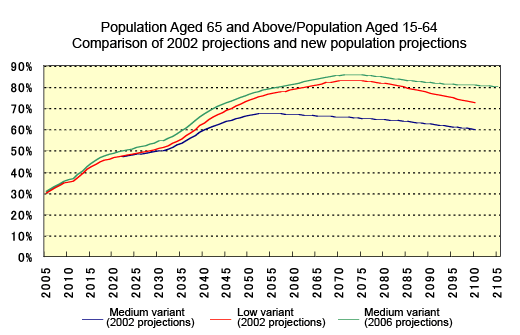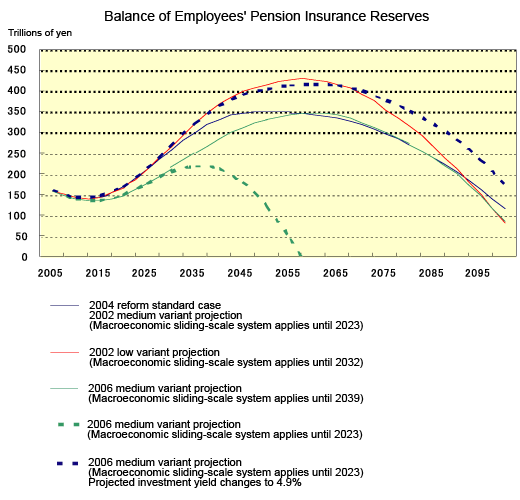This month's featured article
Pension Finance Based on the New Population Projections

NAKATA DaigoFellow, RIETI
Prior to joining RIETI in 2005, Mr. Nakata was a Lecturer in the Venture Business Laboratory at Yokohama National University. His research interests are macroeconomics, endogenous economic growth, social security, numerical simulation, sustainable PAYGO pension systems, and gender-equal society. Mr. Nakata holds an M.A. in Economics from Yokohama National University where he is also a Ph.D. candidate. His major works include: "Establishing Principles for a More Sustainable Pension System in Japan, and Identifying Challenges" (in Japanese), RIETI Discussion Paper 06-J-012, March 2006 (with Mitsuhiro Fukao, Yoshihiro Kaneko, and Ryo Hasumi); "Measures of Tapping the Potentials of Women and Economic Growth" (in Japanese), in Tachibanaki, Toshiaki, ed., Current Issues Surrounding Women at Work and in the Family, Minerva Publishing, 2005 (with Yoshihiro Kaneko); and "Economic Effects of National Pension and Expanded Coverage of Employees' Pension Insurance under the Increase in Non-regular Workers" (in Japanese), The Quarterly of Social Security Research, No. 40, Vol. 2, 2004 (with Yoshihiro Kaneko and Hideki Ishikawa).
Column
Taking the Opportunity of the Release of New Population Projections to Develop a Constructive Debate on Pensions (II) - Forecast for pension finance after the release of "Population Projections for Japan (December2006 Estimate)"
Fellow, RIETI
NAKATA Daigo
Total fertility rate of 1.26
Japan's National Institute of Population and Social Security Research (IPSS) released its "Population Projections for Japan (December 2006 Estimate)" on December 20, 2006. In these, the future total fertility rate (TFR) generally falls between the low and medium variants in the 2002 projections and the TFR at 2055 was set at 1.264 (See chart below). This downward revision of the projection is in line with most estimates and is very close, if not identical, to the figure of 1.245 that I postulated when making a pension finance forecast for the future TFR in my November 2006 column, so I do not consider that as having been off-forecast. Nevertheless, a further look at the projections announced and at the underlying material has made me realize what a major impact the projections will have. In view of this, as a supplement for that column I wish to present a pension finance forecast based on the new estimates.

Both birthrate decline and longevity are advancing
In my column in November 2006, I postulated a TFR of 1.245, and computed provisional population projections using a somewhat rough method, based upon which I made a forecast for pension finance. However, I added the reservation that 2002 data were used for the future life tables (table of estimates relating to survival rates and mortality rates). I was under the impression that the increase in longevity in Japan had progressed as far as it was likely to and that there would be no major upward revisions in the future life tables, but the new Population Projections do envisage a further increase in longevity.

Average life expectancy is projected to rise for both males and females, but compared with the forecast in the previous (2002) projections the degree of improvement in average life expectancy in these new projections is particularly marked among males. In the 2002 projections, the average life expectancy in 2050 was 80.95 years for males and 89.22 years for females, giving a difference of 8.27 years between males and females, but in the new projections the corresponding figures are 83.37 for males and 90.07 for females, giving a difference of 6.69 years (in 2055: 83.67 for males and 90.34 for females, a difference of 6.67 years), suggesting a substantial lengthening of men's lives and narrowing of the difference between males and females. Average life expectancies in IPSS population estimates have hitherto tended to be low relative to United Nations estimates, but in these latest projections they have moved closer together.
Aging advancing more than in previous low variant projections
As a result of this increasing longevity, the age structure of the Japanese population is aging at a far faster pace than could be imagined solely from the value of TFR. Among the figures in the new projections, let us make a comparison with the previous projections by looking at the three age groups (ages 0-14, 15-64, and 65 and above). The chart below shows a comparison based on the ratio of people aged 65 or above to the population aged between 15 and 64; the values are very similar to the (reciprocals of) dependency ratios (the ratio of vested pensioners to pension subscribers) in public pensions.

What is surprising is that the values computed on the basis of the new population projections (TFR 1.26) show that the population structure is aging even more rapidly than the low variant in the previous projections (TFR 1.10). This is the result of the combined effects of the decline in fertility and lengthening of average life expectancy.
The impact on pensions of the new population projections: A rediscussion
The aging of the population structure is naturally a factor that imposes a burden on pension finance. Accordingly, as in my column in November 2006, projections for pension finance can be made under the new population projections by using the simulation model for pension finance developed by our research group (the RIETI model).
However, here again I have one reservation. When new population projections are released by the IPSS, it is normal for it first to release figures that focus on the relevant projection period (until 2055 in this case), followed a little later by detailed tables that include figures for a reference projection period (from 2056-2105 in this case). At the release of the new Population Projections on December 20, 2006 a larger number of tables were released than in previous years, but what have not yet been released are population figures broken down by gender and age for the reference projection period (2056-2105), which are essential for making pension finance projections. Accordingly, I have used figures that have already been released, including population figures broken down by gender and age for the period until 2055, figures for the total population and the population broken down by three age groups and four age groups until 2105, and net migration, and computed the population broken down by age as consistently as possible with figures for the total population and the population broken down by three age groups and four age groups for the period from 2056-2105. I have then used these to make projections for pension finance. Therefore, please note that it is possible that some disparities may arise in population figures.
On this basis I will now present some projections for pension finance based on the new Population Projections, with the stipulation that I have made only provisional calculations for the reference projection period. As in my column in November 2006, as an indicator of the sustainability of pension finance I have examined the trend in the level of the Employees' Pension Insurance (EPI) reserve balance that has been accumulated. As regards factors such as economic assumptions, as in that previous column these match the standard case scenario in the Ministry of Health, Labour and Welfare's 2004 Actuarial Valuation of the Employees' Pension Insurance and the National Pension (2.1% rate of increase in nominal wages, 3.2% nominal investment yield, 1.0% rate of price increases), and the calculation period is until 2100.

In the chart above, the results computed by using the new Population Projections (birthrate medium variant, mortality rate medium variant) are shown by the green lines. The unbroken green line indicates the case in which the period of application of the macroeconomic sliding-scale system is extended to enable pension finance to achieve equilibrium. The broken green line depicts the case in which the period of application of the macroeconomic sliding-scale system is suspended in 2023 in accordance with the forecasts under the 2004 reform.
It can be seen that from the first half of the projection period the EPI reserves remain low relative to the standard case under the 2004 reform (unbroken blue line: when the 2002 medium variant projection is used). This appears to be due to the increase in the amount of pension benefit as a result of the increase in longevity. If the macroeconomic sliding-scale system is suspended in 2023, the EPI reserves hit bottom around 2060. To avoid that and achieve an extent of reserve of 1 (namely, for there to be reserves to match benefits, in this case, for one year) by 2100, I estimate that it would be necessary to retain the macroeconomic sliding-scale system until 2039, though this would have a very severe outcome. It would mean that from 2039 onwards the income replacement ratio of new benefit recipients in the model household (household in which the husband has made contributions for 40 years and his spouse has been a dedicated homemaker for 40 years) would be 41.6%, which is considerably lower than the 50.1% ratio in the scenario in which the application of the macroeconomic sliding-scale system ceases by 2023. In the case (unbroken red line) in which the 2002 low variant projection is used, even though it would suffice to apply the macroeconomic sliding-scale system until 2032 and to have an income replacement ratio of 46.0%, its impact is substantial. (However, according to the actuarial revaluation by the Pension Bureau of the Ministry of Health, Labour and Welfare, the period of the macroeconomic sliding-scale system using the 2002 low variant projection would be until 2031, and the income replacement ratio would be 46.4%, so these projections according to my RIETI model may be slightly harsh.)
The results set out above give a rather severe impression, but please note that these results arise from the fact that the economic assumptions conform with the 2004 reform standard case scenario. The economic assumptions used in actuarial pension revaluation are determined in light of rational and broad-ranging judgments about constantly changing economic circumstances, and the economic assumptions used in the 2004 actuarial revaluation were naturally made on the basis of economic performance up until that time. If an actuarial revaluation were conducted today, then of course the economic assumptions should be revised in parallel. However, since space limitations in this column have not permitted me to discuss what form those revisions should take, on the assumption that the investment yields remain at high levels I have estimated here provisionally what the nominal yield on investment from 2009 onwards would have to be to make it possible for the macroeconomic sliding-scale system to be terminated in 2023 (and possible to achieve an income replacement ratio of 50.1%). The result of this is shown by the broken blue line in the above chart. Our projections have found that if the nominal yield on investment from 2009 onwards is 4.9%, even if the macroeconomic sliding-scale system were to be suspended in 2023 it would be possible to achieve an extent of reserve of 1 in 2100.
The reason why I undertook these estimates as to the necessary investment yield was that among all economic assumptions the fluctuation of the investment yield exerts the largest impact on public pension finance. A characteristic of the Japanese public pension system is that it holds massive reserves while applying a pay-as-you-go method. The amount of the reserves is genuinely very large, and will continue to be built up through a finite balance system at least until around 2050; therefore even a slight fluctuation has a major impact on projections. (I would add here that although increases in wage rates increase premium income they also cause future benefits to rise, and thus do not have as much of an impact on the fiscal balance as investment yields do.)
However, we need to be careful as regards one aspect of the management of the reserves. The Japanese media tends to deride the government's ability to manage the public pension reserves when their investment performance deteriorates, but when investment performance has been good, as it has in recent years, it only reports the facts in a disinterested way. The management of public pension reserves has a unique feature - that is, its amount is excessively large. It is inherently impossible for these massive funds to make skilful use of price fluctuations in the stock and bond markets, by having the government constantly switch the content of the portfolio while monitoring the ever-fluctuating markets and getting the better of other market participants in order to produce superb investment performance. In view of this, the essence of public pension investment is to use the massive amount of funds to engage thoroughly in diversified investment by building the investment portfolio from as varied as possible a range of investment targets, but placing emphasis on unrisky assets such as government bonds. Pension experts are unanimous in believing that average market yields are able to be achieved in this way. In this case, the normal course of events for the investment of public pension reserves is for them to suffer average deterioration in their investment yields when the markets as a whole are not performing well, and average improvements in investment performance when the markets as a whole are performing well. Given this, whatever percent figure is projected as the necessary investment yield here, it is not correct to think that it is the investment performance target that the government and the Ministry of Health, Labour and Welfare must attain. It has to be stated clearly that the correct method is to use yields that are estimated based on consideration of past investment performance and current market conditions.
Author's note: Responsibility for the computations above rests entirely with the author, and all opinions and projections do not necessarily represent those of the Research Institute of Economy, Trade and Industry (RIETI), the Ministry of Economy, Trade and Industry, or the Ministry of Health, Labour and Welfare.
The original column was published in Japanese on January 17, 2007.
Event Information
Fellow titles and links in the text are as of the date of publication.
For questions or comments regarding RIETI Report, please contact the editor.
*If the "Send by mailer" button does not work, please copy the address into your email "send to" field and connect the prefix and the suffix of the address with an "@", sending it normally.RIETI Report is published bi-weekly.

